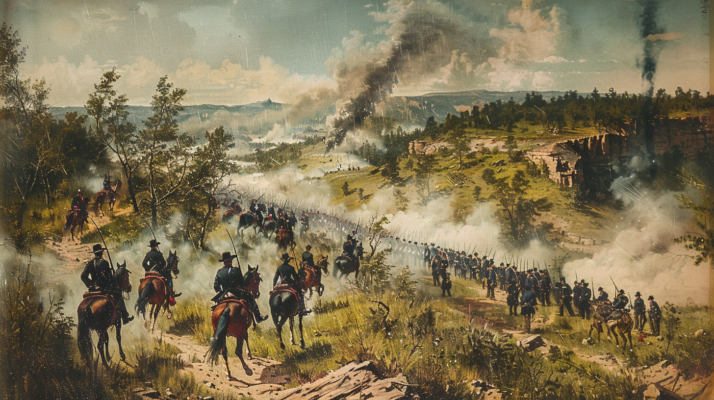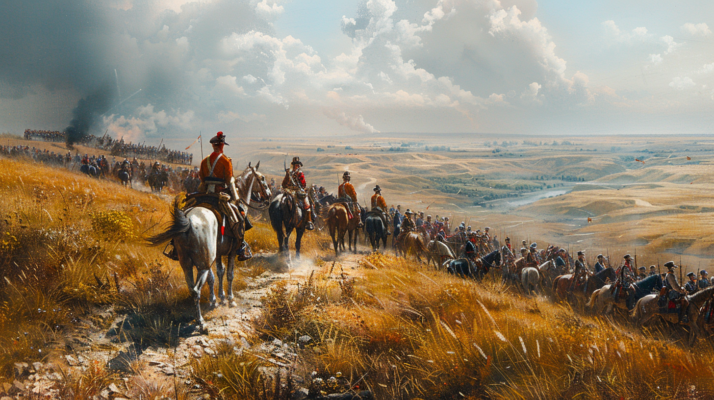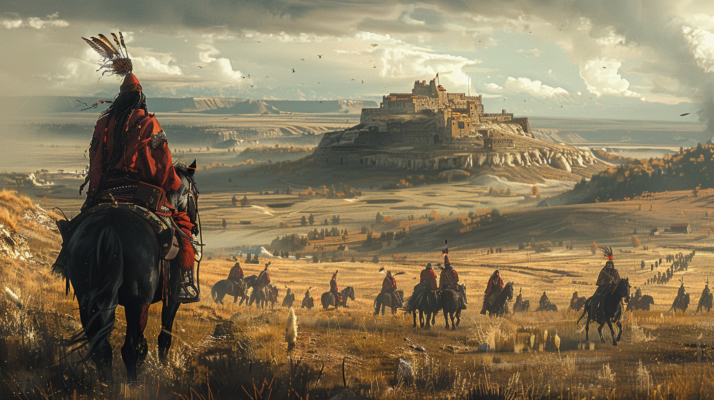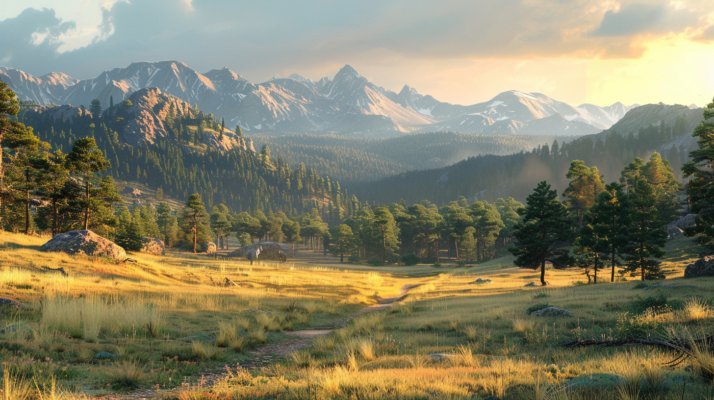June 25, 1876. The Battle of Little Bighorn. A day marked by infamy, bravery, and a mystery that has puzzled historians for generations.
Imagine experiencing it firsthand through the eyes of a man who was there. George B. Herondine’s account isn’t just a historical record; it’s a glimpse into the heart of Custer’s last stand. Prepare yourself to uncover the raw emotions and the untold truths of a battle that shaped American history.
I’ve read many inaccurate accounts of the Little Bighorn battle in the Herald and other papers. Much of it is false and designed to mislead the public. I was with Reno throughout the battle and know what transpired before and after the fight. While I didn’t see everything, I witnessed a great deal and will recount it just as I experienced it.
I was with General Gibbons’ command at the mouth of the Rosebud when Generals Terry and Custer joined us. General Terry allowed me to accompany General Custer on his march up the Rosebud. He informed me of this at General Gibbons’ tent, and I later saw Terry on the steamer Far West, anchored at the mouth of the Rosebud. He asked about the terrain along the upper parts of the Rosebud and Tullock’s Fork.
I was on the forward deck when summoned to the cabin, where I found Generals Terry, Gibbons, Custer, and Brisbane in a council of war. Terry showed me a map and sought my knowledge about the area around Tullock’s Fork and the Little Bighorn. From their conversation, I understood that Terry was determining the best spot for Custer’s and Gibbons’ columns to unite, with Custer marching up the Rosebud and Gibbons up the Bighorn.
Having traveled this terrain, I shared my knowledge with the Generals. Custer seemed pleased with my information and expressed his desire for me to join him. I returned to the deck, and soon General Gibbons approached me to speak. General Custer told me I could consider myself hired to join him as a scout. Once his command reached the head of Tullock’s Creek, I was to bring dispatches down the Tullock to General Gibbons’ command.
We discussed my compensation, but that was the extent of our important conversation. This took place on June 21, and soon after, General Gibbons left the boat. General Brisbane emerged from the cabin, and I asked him where his cavalry would likely be in the coming days, so I could locate them. He replied that they would probably be around the mouth of the Little Bighorn.
On June 21 at noon, I reported to General Custer and was dispatched to Lieutenant Varnum, who oversaw a group of scouts. There, I encountered Mitch Boyer, the half-breed scout and guide, who was with Varnum. We set out on the 22nd around noon, traveling up the Rosebud. Boyer and Bloody Knife, a re-scout, led the way, accompanied by Custer. Lieutenant Varnum and his scouts followed closely behind, ahead of the main column.
We marched for about 12 miles before making camp at 5 p.m. General Custer ordered the bugle to sound reveille at 4 a.m., and the command was ready to march by 5 a.m. on the morning of the 23rd. We set out promptly at 5 a.m., following the stream for four or five miles until we came upon an Indian trail that Reno’s men had followed a few days prior. We continued on the trail until 5 p.m., when we made camp for the night.
In the evening, Custer sent the Crow scouts ahead to gather intelligence. On the morning of the 24th, we broke camp at 5 a.m. and continued up the stream, following the trail. Soon after starting, Custer, who was ahead with Boyer, called me over and told me to prepare, saying he thought he would send me and Charlie Reynolds to the head of Tullock’s Fork to scout ahead.
I told the general it was too early, as we were still heading towards the head of the Tullock and I could only follow the trail. I called Boyer back and asked if I wasn’t correct, and he agreed, saying that further up the Rosebud, we would come across a gap and could cut across to reach the Tullock in about a 15-mile ride. Custer replied, “Very well. I can wait.” We hadn’t gone far when the Crow scouts came running back, reporting that the trail ahead was growing fresher and that they had spotted some new pony tracks. They brought with them the scalp of a white man, which they had found on the trail.
It was later identified as belonging to Stoker, a soldier from Company H, 2nd Cavalry, who had been killed a few days prior at the mouth of the Rosebud. Upon receiving this news, Custer halted the command, dismounted the men, and called the officers together. He held a council with them, but I was too far away to hear the details.
After a half-hour halt, we remounted and continued along the trail at a slow pace. Soon, we arrived at the mouth of Muddy Creek, the site of the 2nd Cavalry’s battle with Lame Deer’s Band the previous spring, 1877. As we crossed Muddy Creek, I noticed some lodges had diverged from the main trail on the Rosebud and headed in that direction.
I followed them briefly, then rode over to Custer and informed him that some of the lodges had gone up the muddy. He immediately halted the command and dispatched Lieutenant Varnum to investigate where the muddy trail led. Custer emphasized that he didn’t want to lose any of the lodges and wanted to be informed if any deviated from the main trail.
While Varnum was away, we halted and the men prepared dinner. He returned after about two hours, reporting that the muddy trail rejoined the main trail further on. We then proceeded on the main trail, which grew fresher by the minute.
We passed areas where multiple camps had been set up close together, indicating the Indians were moving slowly and searching for grazing land. As evening approached, Custer ordered flankers to be deployed and a sharp lookout maintained for any lodges diverging from the main trail. He aimed to capture the entire village and didn’t want any stragglers to escape.
We halted at dusk and made camp on the trail, which was now very fresh. The general sent Varnum, Boyer, and some scouts ahead to reconnoiter the trail and surrounding terrain. The men were instructed to graze their animals, have supper, and be prepared to depart at 11 p.m. Everyone rested until 10 p.m., then packed up and moved out.
The night was extremely dark and our progress was slow. After marching about 10 miles, we halted around 2 a.m., unsaddled the horses, and allowed the men to rest. The packs were removed from the mules, and everything was done to rest and recuperate the animals.
During the night, the scouts returned and informed Custer that they had located the Indian camp. We packed up and advanced at first light. Mitch Boyer and Reynolds, who had been out scouting, reported that the camp was enormous. Boyer exclaimed that it was the largest village he had ever laid eyes on, and Reynolds concurred, saying there was a vast number of them. Custer confidently replied, “I can defeat them.” Reynolds cautioned, however, that it would require six hours of intense fighting to emerge victorious.
On the morning of June 25, the final day of our march, Custer halted his troops and concealed them as best he could. He then took an orderly and rode approximately four miles up to the Divide, where Lieutenant Varnum and Boyer were stationed. The general aimed to catch a glimpse of the village, which lay on the other side of the Divide, along the Little Bighorn.
While Custer was absent, I rode up the dry fork of the Rosebud, following the trail, but hadn’t gone far when I spotted two figures crossing the hills in the direction of the Little Horn. Custer was away for about an hour or an hour and a half, and upon his return, Boyer, who was with him, asked if I had seen the Indians. I replied, yes, I had seen what appeared to be Indians.
Boyer exclaimed, “You were within 150 yards of them, and you surprised them. They fled back to camp as quickly as possible.” Custer sounded Officer’s Call and issued his orders, assigning each officer their position and dividing the column into battalions.
As soon as the orders were given, we advanced up the Divide at a brisk pace, covering three or four miles before reaching the summit. The scouts, led by Lieutenants Varnum and Hare, then pressed on ahead at a gallop, with the command following at a trot. I rode with the scouts, and we followed a creek that flowed towards the Little Bighorn.
As we approached the creek’s mouth, we spotted a lone lodge on the bank. We ascended a hill to flank and overlook the lodge, only to find it abandoned. From the hilltop, we gazed down upon the Little Bighorn and saw a massive dust cloud and fleeing livestock.
We also spotted a few Indians on the hills, riding swiftly and seemingly escaping. I exclaimed that the Indians were getting away, and we needed to hasten our pursuit or risk losing them. Lieutenant Hare penned a note to Custer, though I’m unsure of its contents.
I assumed he shared our belief that the Indians were retreating. Custer was close by, riding at a brisk pace. The scouts charged towards the abandoned lodge, slashed it open, and found a deceased Indian inside.
Custer arrived as we were examining the lodge, with Colonel Reno leading the advance. I overheard Custer instructing Reno, “Reno, take the scouts, lead the way, and I will follow.” Reno immediately spurred his horse into a gallop, advising his men to keep their mounts under control.
My horse stumbled, causing a brief delay, but I quickly caught up with Reno at the fort. As we crossed the river, I heard the Crow Scouts warning each other, “The Lakota are coming to engage us.” Understanding their language, I warned Reno, “The Lakota are coming.”
Reno paused momentarily, allowing the command to close ranks, before crossing the Little Bighorn and forming a battle line on the prairie, just beyond the timber. The formation continued advancing without halting, first at a trot and then at a gallop. As we moved forward, we saw a large force of Indians ahead, seemingly waiting for our approach.
We pressed on for about half a mile, with the Indians setting fire to the timber on our right flank and directly ahead. A few Indians were in the timber, and we fired at them, but they did not return our shots. Shortly after, we dismounted, and the soldiers formed a skirmish line, facing the hills.
The line extended to the left and front, and firing began almost immediately, as the Indians were positioned near the base of the hills in the small valley. The firing intensified quickly, with the Indians maneuvering to our left and attempting to encircle us. Our horses were led into the timber on our right and rear, and the soldiers sought cover among the bushes and small trees.
Within the timber, there was a small clearing where the command regrouped and remounted. I was among the last to reach the timber and paused at the edge to fire at some Indians infiltrating on our left and rear. I then joined the command, now mounted and formed in line of battle within the clearing.
After a brief lull in the firing, we received a volley from the bushes. Bloody Knife, positioned directly in front of me, and Reno, on my left, were both struck. The volley claimed the life of Bloody Knife and one soldier, who cried out as he fell, “Oh, my God, I’ve been hit!” Reno ordered us to dismount, then quickly countermanded it, directing us to remount.
Not all the soldiers managed to get back on their horses when Reno led the charge out of the timber onto the prairie. The men scattered, each one trying to escape the woods as quickly as possible. They ran at an angle, heading toward the Little Bighorn River.
I followed the command out of the timber, with about half of the men ahead of me and the other half behind. The dust was so thick it was impossible to see where we were going. Just as I emerged onto the prairie, my horse stumbled and fell, throwing me off and bolting away.
I retreated back to the timber, about 150 yards, and took cover among the bushes. As I turned back, I heard an officer shout, “Halt! Men! Halt! Let us fight them!” As soon as Reno’s troops emerged from the timber, the Indians swiftly closed in, attacking from all sides. After my horse threw me, I returned to the timber and encountered Lieutenant DiRudio and paused to converse with him.
As we spoke, a group of about a dozen soldiers, some on foot and others on horseback, approached, and I urged them to seek cover in the timber, where we could defend ourselves against the Indians. The soldiers promptly joined us, and we secured our horses to the trees. Just as we settled into our defensive position, firing erupted below, indicating that Custer’s forces had engaged the enemy.
We observed a significant number of Indians departing from their attack on Reno’s troops and racing down the valley. The firing down the valley was intense and sustained, with approximately nine distinct volleys at regular intervals, punctuated by rapid intermediate firing. This heavy firing continued for three-quarters of an hour to a full hour before gradually subsiding into silence.
I turned to the men with me and said, “Boys, it’s time we left.” I pointed out that the fighting below had ceased, and while the outcome was uncertain, I suspected the Indians had gained the upper hand. I cautioned that we should retreat before the Indians returned up the valley.
I led the way, and the men followed. We encountered only five Indians between ourselves and Major Reno’s position. From about a mile away, we spotted Reno’s troops halted on a hill.
I rejoined Reno at 5 p.m. Once we emerged from the timber, we saw large numbers of Indians advancing up the valley. As I ascended the hill, Reno’s forces began moving in the direction Custer had taken, but they were quickly repelled by the Indians and forced back to their original position on the hill. The Indians launched a fierce attack on Reno’s troops, persisting until nightfall.
The next day, June 26, the battle resumed at dawn and continued until 4:01 p.m. The men suffered greatly from thirst, and as many as seven were wounded while attempting to procure water. I believe Captain Benteen saved the fight on the hill. None of us knew with certainty what had become of General Custer until General Terry arrived with Gibbon’s command on the morning of June 27.
The number of Indians that attacked Reno’s command on June 25 could not have exceeded 200 warriors. I do not believe anyone had been killed before his retreat into the timber, and only one man had fallen when he made a break for the bluffs. Contrary to reports, the horses were not exhausted, and the men were not worn out and sleepy when we arrived at the battlefield.
On the contrary, the animals were fresh, and Custer led a set of men who were as well-fed and cheerful as any who ever went into battle. Our initial impression was that the Indians were fleeing, and our only concern was that they might escape before we could engage them. I do not believe Custer’s engagement lasted for a significant duration.
It was undoubtedly concluded within less than two hours. However, at one point, the intensity of the firing led us to surmise that Custer was advancing, and the Indians appeared uncertain about the battle’s outcome. They began dismantling their lodges and packing up the village, suggesting they were preparing to flee.
The distance from the Rosebud’s Mouth, where Custer began his march, to the battlefield at the Little Bighorn’s Mouth spanned over 100 miles. Our daily progress was as follows: 12 miles on the first day, 35 miles on the second, 33 miles on the third, and between 25 and 28 miles on the fourth and final day. We departed at noon on June 22 and arrived at the battlefield around noon on June 25.
Contrary to popular accounts, Custer did not exhaust his men and horses by pushing them excessively. In fact, a heavily laden pack train kept pace with us throughout the journey. From my vantage point, Custer’s movements during the march were deliberate, methodical, and exemplified soldierly conduct in every respect.







